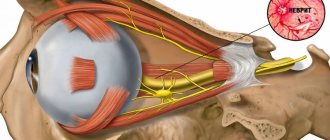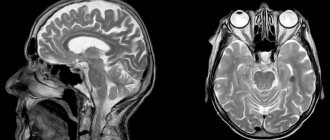- When is Morton's neuroma surgery performed?
- Diagnosis and preparation for surgery for Morton's neuroma
- How does the surgical treatment of Morton's neuroma proceed at the Gelenk Clinic?
- Which surgeon operates on Morton's neuroma?
- What type of anesthesia is offered to the patient before Morton's neuroma surgery?
- Postoperative period, rehabilitation treatment and aids after surgery for Morton's neuroma
- Will I feel pain after Morton's neuroma surgery?
- What are the conditions of stay at the Gelenk Clinic?
- What should you pay attention to after surgical treatment of Morton's neuroma?
- What is the cost of foot surgery?
- How to make an appointment with a doctor and surgery for Morton's neuroma?
Morton's neuroma (red) as swelling between the metatarsal bones (blue).
Irritation of the nerve (yellow) develops a burning and stabbing pain throughout the area of its supply. © Dr. med. Thomas Schneider Morton's neuroma is a benign thickening of the nerves in the metatarsal area. The consequence of the disease is shooting, burning and stabbing pain in the plantar region, as well as in the toes (metatarsalgia). The pain is so severe that the patient experiences relief and improvement in general condition only when he sits down and takes off his shoes. Thus, when the patient is not wearing shoes, the pain goes away much faster. In addition, characteristic symptoms of Morton's neuroma are tingling or numbness in the toes. Morton's neuroma is a common consequence of transverse flatfoot, sometimes accompanied by hallux valgus. Women suffer from Morton's neuroma much more often than men. The reason for this is most likely due to different fashions for shoes: High heels, as well as shoes with pointed toes, put strong pressure on the front arch of the foot and can provoke the appearance of transverse flat feet. As a result of this pathology, the position of the metatarsal bone changes in the patient and the pressure on the nerves passing along the plantar region of the foot increases.
Morton's neuroma is also diagnosed in men, most often in those who engage in high-volume running sports. Morton's neuroma is often observed between the 3rd and 4th toes, and less commonly between the 2nd and 3rd toes.
send a request
When is Morton's neuroma surgery performed?
In order to correctly assess the patient’s condition and prescribe the correct treatment, Gelenk Clinic specialists will need to provide current MRI results. Based on the MRI images, the doctor determines the degree of need for surgical treatment of Morton's neuroma. If there are certain indications, the patient is prescribed the best surgical technique for him.
In the early stages, treatment of the disease is carried out using conservative methods, namely special insoles and gymnastic exercises for the feet. If the quality of life is significantly limited, and if the patient experiences severe pain despite conservative treatment, the doctor will refer him for surgery. If the thickening is 0.8 cm in size, a nerve-sparing operation (neurolysis) is performed. If the swelling of Morton's neuroma is greater than normal, the nerve is removed through neurectomy.
Diagnostics
The diagnosis of Morton's disease is based on the history and clinical manifestations of the disease.
If necessary, instrumental diagnostic methods are used:
- Ultrasound,
- MRI,
- Rg-graphy – to exclude pathology of the metatarsophalangeal joints.
Of diagnostic significance is a sharp increase in pain when the foot is compressed from the edges, and the presence of clicks when palpating the interdigital spaces.
For differential diagnosis and localization, a local anesthetic can be administered.
Diagnosis and preparation for surgery for Morton's neuroma
Clinical examination of Morton's Neuroma using a provocative test (Mulder test): A foot specialist diagnoses the disease by compressing the heads of the metatarsal bones and simultaneously palpating the intermetatarsal spaces, which causes pressing pain. © joint-surgeon
Alternative Causes of Forefoot Pain
- Inflammation of the joint located between the bones of the metatarsal and proximal phalanges
- Nerve damage
- Stress (stress fractures) of the metatarsals
- Changes in soft tissue structure, including scars, warts and tumors
- Incorrect weight distribution, as in the case of severe flat feet
Before starting treatment for Morton's neuroma, the doctor conducts a full clinical and imaging diagnosis, which includes a preliminary conversation, physical examination, and MRI with contrast. During magnetic resonance imaging, the patient is in the “lying on his stomach” position, and during the x-ray in the “standing position”. In order to determine how the pressure is distributed under the plantar part of the foot, a podometric study (pedobarography) is carried out at the Gelenk Clinic. Based on the results obtained, the doctor discusses the upcoming operation with the patient.
If the patient’s health condition does not prevent surgical treatment, the operating doctor tells the patient in detail about the course of the operation and also explains possible complications. In addition, you will be referred to an appointment with an anesthesiologist, who will re-analyze the results of the studies and determine whether your condition allows the administration of anesthetics. As a rule, Morton's neuroma surgery takes place the next day after agreement with the operating surgeon and anesthesiologist.
Clinical manifestations
The initial stages of the disease are characterized by small, mild pain that occurs as a result of mechanical compression of the area between the fingers. Depending on the degree of development of Morton's disease, the following symptoms appear:
- decreased sensitivity of those fingers whose innervating nerve was affected;
- paresthesia - so-called crawling;
- stabbing pain in the fingers as a result of physical activity;
- feeling of burning and/or bloating.
At later stages, a dense formation is determined in the affected area.
How does the surgical treatment of Morton's neuroma proceed at the Gelenk Clinic?
Surgery makes sense if conservative treatment, for example, orthopedic insoles, special shoes with butterfly soles, foot exercises, as well as injections of local anesthetics and self-massage do not help relieve pain for a long time. Gelenk Clinic mainly uses two treatment methods: nerve-sparing neurolysis and nerve removal. Each operation lasts about 30 minutes.
Ventral view of the foot: Morton's neuroma is located between the 2nd and 3rd toes. Most often, pathology occurs between the 3rd and 4th fingers. © Viewmedica
Nerve-sparing minimally invasive surgery for Morton's neuroma
Mechanical pressure on the plantar area of the foot leads to pinched nerves. Due to nerve irritation, the connective tissue sheath of the plantar nerve swells and forms scar tissue. There is an accumulation of fluid.
As a result of the swelling, ischemia occurs and the nerves of the foot are no longer supplied with nutrients. Because of this, the patient develops such characteristic complaints as a feeling of numbness, shooting pain and itching (pins and needles) in the foot. Relieving mechanical pressure on the nerve may relieve these symptoms to a certain extent.
The optimal treatment for many compression syndromes (eg, carpal tunnel syndrome) is nerve decompression. If the Morton's neuroma is less than 0.8 cm in size, nerve-sparing surgery is performed
Using the technique of stress relief and, if necessary, decompression of the nerve by repositioning the metatarsal bone, the specialists of our clinic have been achieving excellent results for several years. In particular, Gelenk Clinic has a good record in preventing relapses. Recurrence of the pathology is more likely after nerve amputation (neurectomy), since this operation does not correct the original violation of the arch of the foot. Despite this, neurectomy is the standard treatment for Morton's neuralgia. Too often, for Morton's neuralgia, the plantar nerve is removed without first testing the effectiveness of nerve-sparing treatment.
Advantages of nerve-sparing surgery:
Nerve-sparing endoscopic treatment of Morton's neuroma with a superior approach instead of the conventional plantar approach has the following advantages:
- less scarring and therefore little irritation of the foot nerves
- the risk of hematomas is reduced
- preservation of the plantar nerve, which after complications will stop hurting and return to its original functions
- reduction in relapse rate: due to the reappearance of painful swelling, relapse is not uncommon
- decreased tendency to form painful scars in the area of the metatarsal nerves
Neuroctomy - removal of the inflamed nerve
During this surgery, diseased nerve tissue from the tibial nerve is removed. At the Gelenk Clinic, neurectomy is performed in cases of severe swelling of Morton's neuroma. That is why this surgical treatment requires a preliminary MRI examination, which helps doctors determine the size of the disease. Since slice-by-slice images obtained using magnetic resonance imaging sometimes do not provide complete information about the size and location of Morton's neuroma, the exact technique is chosen directly during surgery after analyzing and examining the thickening.
With surgical access to Morton's neuroma through the head of the metatarsal bone, decompression can be relatively performed, that is, the degree of compression can be reduced. This method of treatment is an appropriate accompanying surgical procedure, since reducing compression reduces the likelihood of relapse, that is, secondary rupture of the stump of the damaged nerve, resulting in swelling of the connective tissue. Surgery for Morton's neuroma with a superior approach avoids scarring on the sole of the foot. This speeds up the wound healing process, and the patient can resume putting weight on the foot a little earlier.
Etiology
Factors that provoke the disease include:
- Obesity. One of the most common reasons. Excess weight puts excessive pressure on the legs, which over time leads to the development of the disease.
- Infections, injuries, bruises, obliterating vascular diseases (atherosclerosis or microangiopathy in diabetes mellitus).
- Transverse flatfoot.
- Tumor.
- Corns.
A contributing factor is also wearing uncomfortable shoes and staying in a standing position for a long time, which results in overload of the legs.
All of these factors contribute to compression or irritation of the plantar nerve. A response to the stimulus begins to form - the nerve sheath thickens, reactive degeneration of fibers and proliferation of connective tissue occurs. Chronic injuries can also be a contributing factor, resulting in the formation of an inflammatory infiltrate that promotes the fusion of nerve tissue with bone and muscle structures.
Which surgeon operates on Morton's neuroma?
One of the features of the Gelenk Clinic is the trusting relationship between doctors and patients. That is why your attending physician will take care of you from the first examination until the operation itself. This way you will have a specialist whom you can contact at any time convenient for you. The Gelenk Clinic's highly qualified experts in the field of foot and ankle surgery are Dr. Thomas Schneider and Dr. Martin Rinio. Also, Dr. Schneider and Dr. Rinio are certified specialists who are annually audited by the independent German Association of Foot and Ankle Surgeons (German DAF) for advanced training, diagnostics and quality of operative activities. That is why the Gelenk Clinic Orthopedic Medical Center has the honor of being called the Specialized Center for Foot and Ankle Surgery (ZFS).
You have Morton's neuroma: which doctor should you see?
So, we told you how to recognize Morton's neuroma. Who should you contact if you suspect this disease? Let's figure it out.
Your local internist or family doctor . The doctor will identify the presence of a neuroma and make a preliminary diagnosis, or maybe prescribe diagnostics - x-rays, ultrasound or MRI. He will also refer you for a consultation to one or more specialized specialists who will confirm or refute the diagnosis, as well as provide qualified assistance.
For example, the specialty of a podiatrist is to identify and treat foot disorders. A neurologist , taking into account the nervous nature of the disease, will find out whether the pain is associated with damage to the nerve endings. An orthopedist will make a diagnosis taking into account age-related changes in joints and ligaments. He will be able to recognize an enlarged, inflamed neuroma node. An appointment with a rheumatologist is indicated if there is a suspicion that foot pain is the result of salt deposition in the joints. with a vascular surgeon is also prescribed . Its mission is to confirm or refute the presence of blood clots in the vessels of the legs. If you have had leg injuries in the past, it is worth visiting a traumatologist who will check for fractures or dislocations. If the disease is advanced, the therapist will probably refer you to a surgeon .
What type of anesthesia is offered to the patient before surgery?
Typically, surgical treatment of Morton's neuroma is performed under general anesthesia. If the patient refuses this method for personal reasons, there is the possibility of using spinal anesthesia. To do this, the surgeon injects an anesthetic into the spinal canal of the lumbar spine. In this case, the patient is fully conscious. What type of anesthesia is most suitable for the patient is determined during a conversation with the anesthesiologist. Our anesthesiologists are true masters of their craft, who during your appointment will offer you the best method that meets all the indicators of previous examinations.
Will I feel pain after Morton's neuroma surgery?
Every operation is associated with some pain—and Morton's neuroma surgery is no exception. As a rule, we try to reduce pain after Morton's neuroma surgery to a minimum. That is why pain treatment begins already during the operation. In most cases, the anesthesiologist will administer a special injection that will numb the foot for about 30 hours. After this, the pain decreases significantly and the patient’s treatment continues with conventional medications. The main thing for us is to ensure a painless postoperative period.
Gymnastics (physical therapy) for Morton's neuroma
Gymnastics will not only help speed up the blood and relieve pain in the legs, but will also restore the mobility of “stiff” joints. Exercises for Morton's neuroma can be divided into three groups:
- Stretching the muscles of the feet
- To strengthen the muscles of the feet
- For balance
Stretching the foot muscles
Stretching the tissues of the foot helps relieve pressure on the neuroma and therefore reduce pain. IMPORTANT: when performing each exercise, fix your foot in one position for at least 10-15 seconds.
- “Toe towards you - sock away from you”
Sit on the floor or a hard chair. Pull your toe toward your shin as tightly as possible and then extend it forward.
- "Facing the wall"
Stand facing the wall. Raise your palms to shoulder height and press them against the wall. Move one leg back 30 centimeters. Bend the knee of your front leg so that your heels remain pressed to the floor.
- "With a towel"
Grab a small towel, then sit on the floor and stretch your legs out in front of you. Place the front of your foot in the middle of the towel, and take its ends in your hands and pull it towards you.
Strengthening the foot muscles
- "Piano"
Place your feet on the floor. “Play the piano” with your fingers: alternately lift them off the floor, use those toes of both feet at the same time.
- "Pull up the towel"
Spread a towel on the floor and try to gather it into an accordion with your toes.
- "Rotation"
Rotate your foot first clockwise and then counterclockwise. Make your movements as wide as possible.
Balance exercises
It would seem, what does balance have to do with it? And here's what it has to do with it! Maintaining balance improves the biomechanics and mobility of the foot. This will reduce the pressure on the inflamed nerves and reduce the pain.
"On one leg"
Stand on one leg and start moving the other leg while maintaining balance.
"Narrow path"
Lay a narrow ribbon on the floor or mentally draw it. Try to walk along one line and maintain balance.
"Rubber"
Take a gymnastics or any other elastic band and wrap it around your legs. Stand on one leg and lift the other forward, backward and sideways, while stretching the band.
Remember the main rule of exercise therapy for Morton's neuroma: increase the load gradually so as not to aggravate the compression of the painful nerve. If after exercise you feel worse, stop doing therapeutic exercises and consult a doctor.
What are the conditions of stay at the Gelenk Clinic?
Private ward at the Gelenk Clinic in Gundelfingen, Germany.
© joint-surgeon During your stay at the Gelenk Clinic, you are usually in a separate room, which has a shower and toilet. In addition, we provide towels, bathrobes and slippers. You can also use a safe and minibar. All rooms are equipped with TV. You only need to take medications, comfortable clothes and nightwear with you. Patient care is provided around the clock. The medical staff and physiotherapists at Gelenk Clinic will always answer all your questions. Generally, the length of hospital stay is 3 days. Your relatives can stay at a nearby hotel. Our staff will be happy to take care of your room reservation.
What should you pay attention to after surgical treatment of Morton's neuroma?
Immediately after surgery, the foot should be elevated. To avoid pain and swelling, apply a cooling compress to the foot. After about 10 days, the stitches are removed. After this you can take a shower again.
You also receive special shoes that take the load off the forefoot and transfer the body weight to the heel. If you are planning long walks, you should also take elbow crutches. Prevention of thrombosis during the impossibility of full weight bearing on the foot is necessary. This will prevent dangerous blood clots from forming. Physiotherapy and lymphatic drainage prevent muscle loss and swelling of the forefoot. The duration of forefoot swelling often depends on the age of the patient.
- Inpatient treatment: 2 days
- Recommended length of stay in the clinic: 5-6 days
- When can you fly home: 3 days after surgery
- When is it recommended to buy a return ticket: 5 days after surgical treatment
- When is it permissible to shower: after 10 days
- Length of stay on sick leave: 5 days
- When is it recommended to remove stitches: after 10 days
- Outpatient physical therapy
- When can you drive again: in 4-5 weeks
- Sports activity: at least 6 weeks after surgery
Reasons for development
American surgeon Thomas George Morton in 1876 described a syndrome that he observed in 12 patients with unusual foot pain in the area of the 3rd interdigital space. He suggested that this is a consequence of mechanical compression of the nerve by the heads of the metatarsal bones. But today it is believed that in fact the disease is of a polyetiological nature.
The exact mechanism of formation of Morton's neuroma is not yet known, although various studies have been carried out in this direction, thanks to which a substantial amount of knowledge has been accumulated. As a result, there were suggestions that thickening of the nerve most likely becomes a consequence of constant overload of the forefoot, frequent repeated microtraumas, long-term, constantly repeated compression, i.e. squeezing, of the foot and, accordingly, the nerve. There is also evidence that nerve thickening can form as a result of ischemic phenomena, i.e., nutritional disorders, which can be observed when the walls of the blood vessels supplying a given area of the foot thicken or their lumen is completely blocked.
Therefore, today it is believed that nerve compression and constant microtrauma lead to a gradual thickening of the transverse intermetatarsal ligament of the foot with its disintegration and the development of edema. The formed pathological intermetatarsal ligament causes constant compression and displacement of the medial plantar nerve and the vessels that supply it, which provokes the occurrence of ischemic phenomena and compensatory thickening of the plantar nerve sheath.
Additional factors contributing to the development of the disease may be damage to bones and soft tissues, as well as the development of the inflammatory process, which is accompanied by the formation of an infiltrate. All this can lead to the nerve becoming firmly fused with the surrounding tissues, its sheath thickening to protect the delicate structure from damage, resulting in the formation of a space-occupying lesion. Since the distance from the intermetatarsal nerve to the metatarsal bones and interdigital ligament is extremely small, these anatomical structures compress the overgrown nerve sheath, i.e., its compression occurs, which causes the occurrence of tunnel syndrome with all its manifestations.
It is believed that genetic predisposition also plays a role in the occurrence of Morton's neuroma. Although the action of external and internal factors is still given leading importance.
Thus, the main reasons for the development of the disease are:
- transverse flatfoot and/or development of valgus deformity of 1 toe (Hallux Valgus);
- wearing shoes that are too tight, in particular narrow shoes with high heels, which explains the fact that the pathology is 4 times more common in women;
- injuries and formation of hematomas at the site of the nerves of the foot;
- gait disturbances with the foot turning inward, which leads to excessive tension on the nerve;
- vascular pathologies of the lower extremities, accompanied by fusion or closure of their lumen and acute circulatory disorders, i.e. obliteration (obliterating atherosclerosis, endarteritis of the lower extremities);
- obesity, leading to increased stress on the legs and feet in particular;
- increased loads on the forefoot;
- inflammatory diseases of the joints and ligaments of the feet (bursitis, tendovaginitis);
- some infectious and autoimmune diseases;
- lipomas of various types in the metatarsal area;
- changes in nerve anatomy.
Very often, Morton's neuroma occurs in women who constantly wear tight high-heeled shoes, as well as in people who actively engage in sports or are forced to stand for long periods of time. Excess weight and heavy physical labor or overly active sports are the main causes of pathology in men.
Pregnancy can act as a trigger for the rapid development of the disease. This is due to the relatively rapid increase in a woman’s body weight, which leads to an increase in the load on the foot. Therefore, it is extremely important from the first days of pregnancy to wear comfortable, non-squeezing shoes and avoid too much stress.
Thus, the risk group for developing Morton's neuroma includes:
- women who constantly wear narrow high-heeled shoes;
- people who are forced to stand or walk for a long time due to the nature of their profession (salespeople, teachers, flight attendants, waiters);
- people engaged in heavy physical labor (loaders, professional athletes, especially figure skaters, speed skaters, track and field athletes);
- patients with any diseases and deformities of the feet, especially flat feet, bursitis, arthrosis, tendinitis, tumors, hallux valgus.
What is the cost of foot surgery?
In addition to the cost of surgical treatment for Morton's neuroma, it is worth considering the additional costs for diagnostics, doctor's appointments and aids (eg elbow crutches), amounting to approximately 1,500 to 2,00 euros. If you plan to undergo outpatient physical therapy treatment after surgery, we will be happy to provide you with an estimate of the costs. Information regarding the cost of hotel accommodation and possible additional treatment at a rehabilitation center can be found on the corresponding website.
Causes of the disease
Morton's neuroma develops as a result of compression, irritation and inflammation of the nerve in the intermetatarsal space.
There are a number of conditions that contribute to the occurrence of pathology. Intermetatarsal neuroma can develop when:
- transverse flatfoot;
- tight shoes with high heels;
- callus formed after injury;
- hematoma in the area where the nerve is located;
- with obliterating atherosclerosis of the vessels of the legs;
- with excess weight putting pressure on the tissues of the lower extremities;
- long running and walking.
How to make an appointment with a doctor and surgery for Morton's neuroma?
First of all, to determine the size of Morton's neuroma, as well as to diagnose possible other diseases, foot specialists in Germany will need current MRI images of the foot and X-ray results. Once we receive all the necessary documents, within 1-2 business days we will email you information for patients, as well as a preliminary cost estimate for treatment of Morton's neuroma.
Foreign patients can make an appointment for Morton's neuroma surgery in a short time. We will be happy to assist in obtaining a visa after the advance payment indicated in the estimate has been received into our account. If a visa is not issued, the amount received is returned to you in full.
Due to sometimes long flights, we try to keep the time between the first examination and surgery to a minimum. During outpatient and inpatient treatment of Morton's neuroma, you will be able to use the services of qualified medical personnel who speak several foreign languages (eg English, Russian, Spanish, Portuguese). Payment for a translator (for example, into Arabic) is carried out separately. We also organize transfers, we can book a hotel room, and we will tell you how to spend time in Germany for you and your relatives.
send a request
How to treat Morton's neuroma of the foot?
If a patient is diagnosed with Morton's neuroma, treatment begins with reducing the weight on the foot. This is required to slow down the destructive process and prevent pain. As a first step, experts advise purchasing more spacious shoes with heels up to 4 cm or starting to wear an orthopedic model.
Also, for Morton's neuroma, you can use orthopedic insoles , which allow you to restore the optimal position of the transverse arch of the foot. As an additional device, it is recommended to use special pad inserts, which are placed at the base of the metatarsal bones.
If a patient is diagnosed with Morton's neuroma, timely measures can achieve the following effects:
- Minimize the load on the front of the foot and restore the optimal position of the transverse arch;
- Reduce the pressure of ligaments and bones on the nerve;
- Restore biomechanical functions;
- Stop inflammation near the nerve.
Use of medications
In combination with the use of orthopedic devices, Morton's neuroma can be treated with medications:
- In case of a painful attack of increased intensity, the hormonal drug Diprospan or the potent painkiller Novocain are prescribed. The above medications must be used monthly;
- To relieve inflammatory manifestations and eliminate pain, steroid hormones from the subclass of corticosteroids are often prescribed, which are injected into the affected area;
- For pain of moderate intensity, it is recommended to use Baralgin, Nurofen and Ketoprofen;
- To eliminate muscle spasms, the muscle relaxants Mydocalm and Sirdalud are used.
To obtain a prolonged positive effect from the use of the above drugs, they must be used for at least three months.
Physiotherapy for Morton's disease
For Morton's neuroma, additional treatment involving the use of physiotherapeutic procedures is prescribed. Due to this, it is possible to increase the effectiveness of the use of drugs, as well as improve metabolic processes in the affected area.
So, for tunnel neuropathy, it is advisable to perform the following procedures:
- Effect on the body of an alternating magnetic field;
- Exposure to shock waves;
- The use of needles inserted into acupuncture points;
- Exposure of the body to direct electric current simultaneously with the introduction of special medicinal compounds through the skin;
- Massotherapy. It is carried out starting from the ankle and ending with the fingertips.
In some situations, there are restrictions on the use of physiotherapeutic methods. These include:
- Presence of wounds on the skin;
- Pustular skin lesions;
- Pathologies of the circulatory system;
- Formations of a malignant nature;
- Cardiovascular failure.
Use of shockwave therapy for Morton's neuroma
As stated earlier, treatment of Morton's neuroma in Moscow begins with the use of special orthopedic devices. These include insoles, which play a key role in Morton's neuroma, as they allow you to restore the optimal position of the transverse arch of the foot. The patient is also recommended to use non-steroidal anti-inflammatory drugs, injections with steroid hormones, and painkillers.
If conservative methods do not give the desired effect, experts recommend removing Morton's neuroma. However, not all patients with this pathology undergo surgical intervention.
A more gentle and effective way to eliminate the disease is considered to be the SWT , which gives an excellent effect for Morton's neuroma - it improves blood flow in the affected area.
The technique is based on the use of shock waves that affect the nerve trunk. This provides the necessary analgesic effect, helps eliminate the inflammatory process and helps normalize restoration processes in tissues.
The advantages of the procedure also include:
- Increased comfort for the patient;
- Safety;
- Non-invasive nature;
- Quickly achieve the desired result.
In our medical center, the UVT technique is the priority method for eliminating neuroma. The use of innovative Swiss equipment, an individual approach to the problem and the high professionalism of doctors make it possible to obtain maximum efficiency in its implementation.
Removal of Morton's neuroma
If there is no positive result from conservative methods, the doctor refers the patient to surgery.
Today, the following methods are known for surgical removal of compaction in the area of the frontal part of the foot. These include:
- Resection of the formation. In this case, a small incision is made in the intermetatarsal area and the seal is completely removed. After this, suturing is performed. At the same time, there is no need to implement measures to ensure foot immobility;
- Dissection. It is considered more gentle. In this method, the affected ligament is divided into fibers, which eliminates nerve compression;
- Using a surgical laser. This procedure is famous for its low trauma and does not limit the patient’s motor activity in the future;
- Radiofrequency catheter ablation. The method is minimally invasive. For Morton's neuroma, it is carried out in combination with ultrasound diagnostics . In this case, the seal is destroyed when exposed to electric current;
- Shift of the fourth metatarsal bone. Performed in isolated situations. Using a similar procedure, it is possible to eliminate compression of the nerve. If a patient is diagnosed with Morton's neuroma, bone displacement surgery and subsequent rehabilitation are carried out under x-ray guidance.
By contacting us about seal removal, you will receive a guarantee of a safe and accurate surgical intervention, as well as quick and easy rehabilitation after it. This is due to the presence of highly qualified surgeons in the state, who have hundreds of similar operations behind them.










